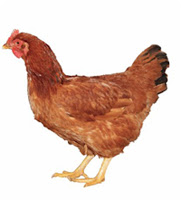Mites: Poultry External Parasites
There are three (3) major types mites as a form of ectoparasites in poultry. They are Red mite, Northern fowl mite and Scaly leg / Depluming mites. All types are capable of invading at anytime and cause several health issues which can negatively affect the birds, the farm owner's health and profit.
1. Red Mite
The Red mite, Dermanyssus gallinae, is a blood sucking ectoparasite that can infest and feed on chickens and turkeys. They can invade at anytime especially during hot season. Red mite can be challenging to spot unless you have a population explosion whereby they are difficult to ignore. They are nocturnal so they hide in crevices of the poultry house during the day and emerge at night to crawl up the bird’s legs to feed on the chicken's blood.
2. Northern fowl mite
Northern fowl mite, Ornithonyssus bursae, is an oval shaped mite about 1mm in size. It starts its life as a pale grey colour, then start feeding on chicken's blood till it becomes engorged mite of a black or brown colour.
3. Scaly leg / Depluming mites
Scaly leg mite and depluming mites are two closely related mites and belong to the genus Knemidocoptes. Scaly leg mite, Knemidocoptes mutans, commonly infests older birds by burrowing into the scales and cause tissue damage with white crusting which can become infected.
Depluming mite, Knemidocoptes gallinae, burrows into the feather shafts especially the head, neck, upper leg, back and belly. The burrowing causes damage to the tissue for mites to feed on.
Signs
a) Red Mite
* Presence of grey/red mites up to 0.7mm, around vent of birds and in housing, particularly crevices.
* Birds are often restless due to the irritation.
* May cause anaemia (pale comb and wattles) and potentially death.
* Drop in egg production.
* Blood spots on eggs.
* Staff/owner complaints of itching.
b) Northern fowl mite
* Blackened feathers.
* Scabby skin around the vent.
c) Scaly leg / Depluming mites
* Scales and crusts in the legs, combs and wattles.
Prevention And Treatment
a) For Red mite:
* Clean your poultry house once in a month with good disinfectants.
* Use appropriate mite powder (Diatomataceous earth) this can be applied to the bird, particularly paying attention to under the wings and the vent, also apply in nest boxes, rub onto the perches and even place in a cat litter tray, so birds can dust bath in it (mix with some dry earth), a repeat application 2 weeks later is recommended.
* Multivitamins are advised to be used to support the bird during a severe red mite infestation, as this a stressful time and will aid recovery; we recommend you use these for 5 days in the drinking water.
b) For Northern fowl mite:
* Monitor all birds and facilities for infestation; check egg trays and cases.
* Treat the birds with approved insecticides; use dry powder to dust birds and liquid or wettable powder for walls, floors and crevices.
* Wash plastic flats and racks with hot water and detergent.
c) For Knemidocoptes:
* Isolate the affected birds.
* Apply oil based products like petroleum jelly or 1:1 kerosene and cooking oil to the affected area.
For quick updates and comments, follow us on our social media connects; FacebookPage, TwitterHandle and Instagram. You can also subscribe and watch videos on our YouTube channel. At Artib Farm, we materialize your satisfaction!
References
1. http://www.chickenvet.co.uk/health-and-common-diseases/mites-lice/index.aspx
2. Common Poultry Diseases And Their Prevention, Dr Nathaniel Tablante, Regional College Of Veterinary Medicine, University of Maryland, 2013.






Comments
Post a Comment